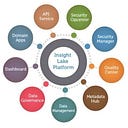Broker 360
Creating an Insurance Broker 360 Data Model involves compiling a comprehensive view of all data points relevant to an insurance broker’s relationship, interactions, performance, and compliance with an insurer. This model aims to provide a 360-degree view of brokers, helping insurers manage broker relationships, optimize sales, and track performance.
Below is a detailed Insurance Broker 360 Data Model with key data fields:
1. Broker Profile Information
- Broker ID: Unique identifier for the broker.
- Name: Full name of the broker.
- Business Type: Type of business (e.g., independent, captive, MGA).
- License Number: Regulatory license number(s).
- License Expiration Date: License expiry date(s) to ensure compliance.
- Certification: List of certifications and accreditations.
- Primary Contact Information:
- Phone Number
- Email Address
- Physical Address
- Agency/Company Name: Broker’s affiliated agency or company.
- Agency Type: Type of agency (e.g., national, regional, boutique).
- Office Locations: List of broker’s office locations.
- Years in Business: Number of years the broker has been in business.
- Areas of Expertise: Specialty areas (e.g., property, liability, health).
- Geographical Focus: States or regions where the broker operates.
- Website URL: Website link for reference.
2. Compliance and Licensing
- License Status: Current status (active, suspended, expired).
- License History: Historical license details.
- Background Check: Background check status and results.
- Compliance Violations: Any recorded regulatory violations.
- Continuing Education Requirements: Status of required continuing education.
- Regulatory Filings: Details of any mandatory filings.
3. Broker Relationships and Affiliations
- Insurer Partners: List of insurers the broker is authorized to represent.
- Network Affiliations: Affiliations with broker networks or associations.
- Strategic Alliances: Any key partnerships with industry players.
- Hierarchy: Relationship structure within an agency or brokerage firm.
4. Broker Performance Metrics
- Total Premium Written: Total premium value written over a specific period.
- Policy Count: Number of policies sold by the broker.
- Renewal Rate: Percentage of policies renewed.
- Loss Ratio: Ratio of claims paid to premiums collected.
- Customer Satisfaction Score: Based on customer feedback or surveys.
- Commission Earned: Total commissions earned on sales.
- Cross-Sell/Upsell Rate: Rate at which additional products are sold.
- Customer Retention Rate: Percentage of customers retained.
- Revenue per Customer: Average revenue generated per customer.
5. Customer Demographics Managed
- Customer Segment: Type of customer (e.g., individual, small business, large business).
- Industry Focus: Industries broker frequently services (e.g., retail, construction).
- Demographics: Key demographics of broker’s client base.
6. Sales and Marketing Data
- Lead Sources: Sources of leads generated by the broker.
- Campaign Participation: Participation in co-marketing or joint campaigns.
- Conversion Rate: Percentage of leads converted to customers.
- Sales Cycle Duration: Average time taken to close a sale.
- Sales Growth Rate: Growth rate in terms of sales year-over-year.
- Customer Acquisition Cost: Average cost to acquire a new customer.
7. Policy and Product Details
- Products Sold: Types of policies sold (e.g., auto, home, health, life).
- Policy Count per Product: Number of policies sold per product type.
- Average Policy Size: Average premium size per policy.
- Product Portfolio Diversity: Range of products offered by the broker.
8. Claims and Servicing
- Claims Volume: Total number of claims processed through the broker.
- Claim Types: Types of claims handled (e.g., auto, property, liability).
- Average Claim Resolution Time: Average time taken to resolve claims.
- Claims Ratio: Claims paid as a percentage of premiums collected.
- Customer Complaints: Number and nature of complaints associated with the broker.
- Support Ticket Count: Total number of support interactions recorded.
- Service Rating: Rating based on customer feedback on service quality.
9. Financial Data
- Commission Structure: Details of commission structures for various products.
- Commission Rate: Average commission rate across products.
- Payment Terms: Terms of payment agreed with the broker.
- Outstanding Payments: Unpaid commissions or claims payments.
- Incentive Payments: Bonuses or incentives paid to the broker.
- Revenue Contribution: Broker’s revenue contribution to the insurer.
10. Market and Competitive Intelligence
- Market Share: Broker’s market share within a given product line or region.
- Competitive Positioning: Analysis of broker’s position in comparison to peers.
- Growth Rate: Year-over-year growth of the broker’s business.
- Industry Trends: Relevant trends impacting the broker’s business.
11. Risk and Compliance Indicators
- Risk Assessment Score: A score based on the broker’s risk profile.
- Compliance Violations: Record of any regulatory or compliance issues.
- Financial Stability: Broker’s financial stability assessment.
- Insurance Coverage: Errors and Omissions (E&O) insurance details.
12. Digital Engagement and Technological Proficiency
- Digital Engagement Score: Based on broker’s engagement in digital platforms.
- Training Participation: Engagement in digital or technology training sessions.
- Tech Stack Utilization: Types of technology used by the broker (CRM, AI tools).
- Website/SEO Score: Website presence and search engine ranking.
13. Interaction History and Engagement
- Contact Log: Record of all interactions with the insurer.
- Recent Communications: List of recent calls, emails, and meetings.
- Customer Feedback: Feedback and ratings from customers about the broker.
- Engagement Score: Based on the frequency and quality of broker-insurer interactions.
- Training Sessions Attended: Training or workshops the broker has attended.
This data model can be implemented in a relational or NoSQL database, depending on the complexity and volume of data, and can also be integrated into CRM and analytics platforms. By leveraging this 360-degree view, insurers can optimize broker relationships, enhance operational efficiency, and support data-driven decision-making to drive growth and profitability.
